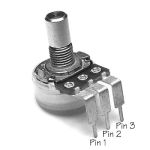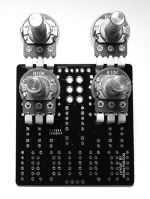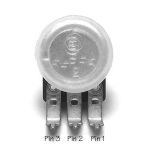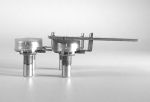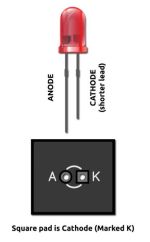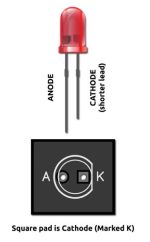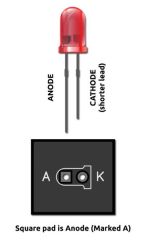3PDT Order Switch Wiring and General Build Instructions: Difference between pages
mNo edit summary |
(Created page with "== Introduction == This page is a work in progress. == Potentiometers == Most PedalPCB boards are designed for use with 16mm right-angle pin PCB mounted potentiometers. thumb|left|upright=0.50|Right-angle 16mm potentiometer thumb|right|upright=0.50|Right-angle 16mm potentiometers installed in a PCB File:16mmPotentiometer-Back.jpg|thumb|left|upright=0.50|Right-angle 16mm potentiometer with pla...") |
||
| Line 1: | Line 1: | ||
[[File: | == Introduction == | ||
This page is a work in progress. | |||
== Potentiometers == | |||
Most PedalPCB boards are designed for use with 16mm right-angle pin PCB mounted potentiometers. | |||
[[File:16mmPotentiometer.jpg|thumb|left|upright=0.50|Right-angle 16mm potentiometer]] | |||
[[File:16mmPotentiometerInstallation.jpg|thumb|right|upright=0.50|Right-angle 16mm potentiometers installed in a PCB]] | |||
[[File:16mmPotentiometer-Back.jpg|thumb|left|upright=0.50|Right-angle 16mm potentiometer with plastic dust cap installed]] | |||
[[File:16mmPotentiometerInstallation-Side.jpg|thumb|right|upright=0.50|Side view of right-angle 16mm potentiometers installed in a PCB]] | |||
=== Pin Designation === | |||
Pin 1 of a potentiometer is defined as the left-most pin when looking at the potentiometer with the shaft facing you. | |||
=== Installation === | |||
Unless otherwise noted in the specific project documentation, potentiometers (except trim pots) should be installed on the back side of the PCB (opposite of components). Pin 1 of the potentiometer should be installed into the square pad on the PCB. Potentiometers will extend towards the top of the enclosure, and typically the top row of potentiometers will fit underneath the top mounted 1/4" jacks. | |||
=== Dust Caps === | |||
Potentiometers installed underneath the PCB should be insulated with dust caps or some other insulating material to prevent contact with the back of the PCB. | |||
=== Taper === | |||
Potentiometer taper is indicated by a letter prefix before the value. (eg: B50K would indicate a 50K Linear taper potentiometer) | |||
===='''A''' - Logarithmic (Audio) Taper ==== | |||
===='''B''' - Linear Taper ==== | |||
===='''C''' - Anti-Logarithmic (Reverse Log) Taper ==== | |||
===='''W''' - W-Taper ==== | |||
W-taper is log taper for the first 50% of rotation, then reverse-log for the last 50% of rotation. These are typically used in tone control circuits. | |||
===='''G''' - G-Taper ==== | |||
G-taper is the opposite of W-taper. The taper is reverse-log for the first 50% of rotation, then log for the last 50% of rotation. These are primarily seen in Boss pedals. | |||
== Light Emitting Diodes (LEDs) == | |||
Proper LED orientation varies depending on the symbol printed on the PCB. | |||
[[File:LED-Footprint-Standard.jpg|thumb|left|upright=0.50|Standard LED footprint]] | |||
[[File:LED-Footprint-5mm.jpg|thumb|right|upright=0.50|5mm LED footprint]] | |||
[[File:LED-Footprint-3mm.jpg|thumb|right|upright=0.50|3mm LED footprint (no longer used)]] | |||
=== LED footprint === | |||
==== Standard LED footprint ==== | |||
This is the standard LED symbol that will be used by all PedalPCB projects. All other LED footprints will be progressively phased out. Note that the Cathode of the LED is installed into the square pad of the PCB. | |||
==== 5mm LED footprint ==== | |||
This is the footprint commonly used for 5mm LEDs. Note that the Cathode of the LED is installed into the square pad of the PCB. | |||
==== 3mm LED footprint ==== | |||
This is the footprint commonly used for 3mm LEDs. The pinout of this footprint is technically incorrect; the anode is installed into the square pad of the PCB. This footprint will be progressively phased out of all projects as new stock is ordered. | |||
= Jacks = | |||
[[File:1-4" Jack Pinout.jpg|thumb|left|1/4" enclosed jack pinout]] | |||
Revision as of 16:35, 2 January 2023
Introduction
This page is a work in progress.
Potentiometers
Most PedalPCB boards are designed for use with 16mm right-angle pin PCB mounted potentiometers.
Pin Designation
Pin 1 of a potentiometer is defined as the left-most pin when looking at the potentiometer with the shaft facing you.
Installation
Unless otherwise noted in the specific project documentation, potentiometers (except trim pots) should be installed on the back side of the PCB (opposite of components). Pin 1 of the potentiometer should be installed into the square pad on the PCB. Potentiometers will extend towards the top of the enclosure, and typically the top row of potentiometers will fit underneath the top mounted 1/4" jacks.
Dust Caps
Potentiometers installed underneath the PCB should be insulated with dust caps or some other insulating material to prevent contact with the back of the PCB.
Taper
Potentiometer taper is indicated by a letter prefix before the value. (eg: B50K would indicate a 50K Linear taper potentiometer)
A - Logarithmic (Audio) Taper
B - Linear Taper
C - Anti-Logarithmic (Reverse Log) Taper
W - W-Taper
W-taper is log taper for the first 50% of rotation, then reverse-log for the last 50% of rotation. These are typically used in tone control circuits.
G - G-Taper
G-taper is the opposite of W-taper. The taper is reverse-log for the first 50% of rotation, then log for the last 50% of rotation. These are primarily seen in Boss pedals.
Light Emitting Diodes (LEDs)
Proper LED orientation varies depending on the symbol printed on the PCB.
LED footprint
Standard LED footprint
This is the standard LED symbol that will be used by all PedalPCB projects. All other LED footprints will be progressively phased out. Note that the Cathode of the LED is installed into the square pad of the PCB.
5mm LED footprint
This is the footprint commonly used for 5mm LEDs. Note that the Cathode of the LED is installed into the square pad of the PCB.
3mm LED footprint
This is the footprint commonly used for 3mm LEDs. The pinout of this footprint is technically incorrect; the anode is installed into the square pad of the PCB. This footprint will be progressively phased out of all projects as new stock is ordered.
